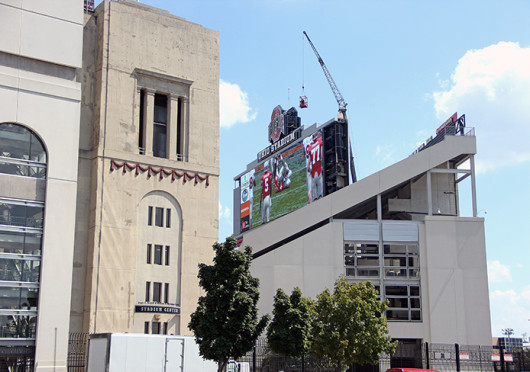
The Zero Waste initiative is a recycling program that has been in place at Ohio Stadium since the fall of 2011. Credit: Lantern file photo
To continue with a goal of being a “Zero Waste” school by 2030, Ohio State has launched the tailgate recycling program aimed at recycling materials come gameday.
And other sustainable practice initiatives at and around Ohio Stadium have been created to divert football gameday waste from landfills as well, said OSU spokeswoman Alison Hinkle.
“Zero Waste” means diverting 90 percent or more material from the landfill by recycling, composting and repurposing, Hinkle said in an email.
OSU launched “Zero Waste” at Ohio Stadium in 2011 to decrease gameday waste.
But while “Zero Waste” is inside the stadium strictly, which involves compost recycling only,the surrounding area in the tailgate lots that OSU owns is the tailgate recycling program, which is strictly recycling and not compost, said tailgate recycling program student intern ambassador Jon Hoge.
Originally, the University Sustainability Fund provided $50,000 to fund the university’s “Zero Waste” efforts. Now, the Ohio Stadium “Zero Waste” initiatives are funded fully through the OSU Athletics department, Hinkle said.
The total budget for initiative is still about $50,000, said Donald Patko, assistant athletic director for facilities for the OSU Department of Athletics.
Tailgate recycling student volunteers and 16-20 city-wide high school student employees contracted through the “Zero Waste” initiative’s partner Tailored Management are available at each game to help fans determine what can be recycled, said Hoge, a fourth-year in mechanical engineering. Tailored Management is a national staffing agency based in Columbus, according to its website.
“Some of them pass out recycling bags, some of them just interact with fans and encourage them to recycle,” Hoge said.
Hinkle said the stadium itself does not require the presence of trash cans because food and vendor products sold in the stadium must be recyclable or compostable. But within university-specified tailgate lots, Hoge said there are as many as 33 recycling bins.
Hoge said the tailgate lot volunteers try various methods to encourage fans to recycle.
One such method is rewarding people who offer bags of recycled items to volunteers at the dumpsters. Those people are rewarded with entry into a raffle prize, which so far this year has been customized OSU jerseys, Hoge said.
After the game, if any materials that were thrown away at tailgates or in the stadium are not compostable or recyclable, they are weighed and stored into a separate bin until the end of the season when it is taken to the Franklin County Landfill, Hinkle said.
The specific numbers for a specific OSU game’s waste are hard to track from the landfill’s perspective because the waste is not tracked by venue, but by the hauler contracted with OSU’s stadium. The material picked up by each hauler is often a mix of different sources for waste, said Solid Waste Authority of Central Ohio director of planning and programs Albert Iosue.
Hoge said it is hard to determine the actual amount of material successfully recycled and composted from each individual game even from the university’s standpoint.
“It depends game to game, some games are bigger than other ones and some of the data comes back pretty late,” Hoge said.
According to an OSU website, the university reached a game-high total of a 98.5 percent waste diversion rate from the 2013 game against Wisconsin. This was the highest landfill diversion of any of the 88 participating schools in the nationally campaigned Gameday Recycling Challenge, Hinkle said.
The nationwide collegiate challenge is sponsored by Busch Systems to promote waste reduction at football games, according to its website. OSU was named a 2012 and 2013 Diversion Rate Champion of the challenge.
A resultant 1.46 million pounds of waste from football games were diverted from landfills from the 88 schools in 2013, Hinkle said.
“It’s a really good idea,” said Susi Martinez, a second-year in international studies. “There is so much waste and students usually just forget about it. I think having the initiative is good especially at tailgates because football is so big here.”
Although some students were supportive of the initiatives taken by OSU to combat on-campus waste, some felt that the efforts could be better directed.
“I think it’s a much bigger problem off-campus,” said Jake Fernberg, a third-year in English. “I understand why they’re focusing on the stadium because people pay money to go to the stadium and they don’t necessarily care about east of High (Street). I know walking back to my house, it’s much grosser than anywhere in the stadium.”
Hoge said overall, it’s his strong interest in the environment and the overall fan enthusiasm that has fueled his participation in the tailgate recycling program.
“It’s just been really insightful to see how you can get fans to recycle and how a lot of them care about it a whole lot. People love to see us in the lots,” Hoge said.



